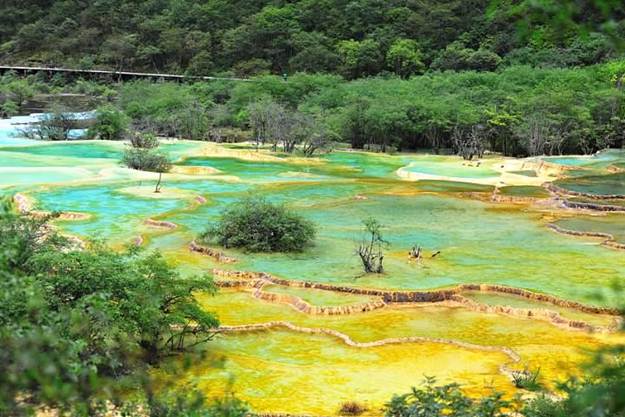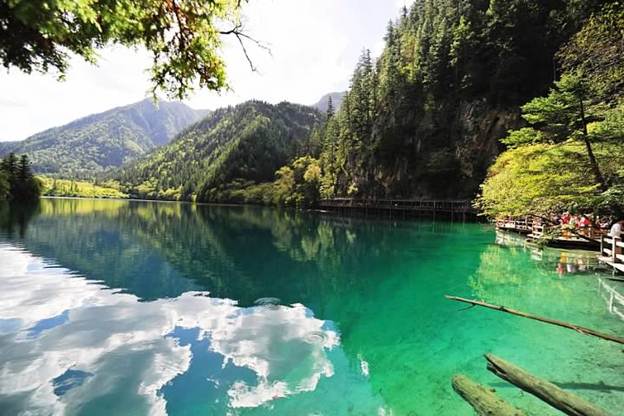News & Updates
Lotus - A trusted name in family travel
Editor’s note: Here is an interview excerpt of discussion with Louie Yi, President of Lotus Travel. This article includes some of his photographs and is followed by informational article on Jiuzhaigou, the UNESCO World Heritage site he visited.
Louie’s Photos & Visit to Jiuzhaigou
Editor: “Louie, you recently visited Jiuzhaigou Valley, which is considered very similar in its makeup as Yellowstone Park in America. What were some of the highlights from visiting this park?”

Louie: “Well, I had visited this park approximately 10 years ago when it was more rugged and less accessible. Now it is easy to reach for most tourists, as there is an airport there and a tourist bus can bring you to many of the key sites and stops. This place has many beautiful and unique locations in the park. There is a lot of walking – a lot of up and down walking. I spent 3 days there and did a lot of walking, but it is not too challenging. There are many beautiful lakes and waterfalls in this park. I took several of the waterfall photographs in this park. I did not have a tripod, but used a rock to steady the camera as I took waterfall pictures with timed exposures and f22 aperture. Here is one.

It is easy for most tourists, as the bus will stop at most key scenic spots for people to get out and look. It is certainly not as physically demanding as Tibet, but Tibetan people do live there. “
Jiuzhaigou Valley National Park

The name “Jiuzhaigou” literally means “Valley of Nine Villages”, which refers to the nine Tibetan villages along the length of the valley. It is part of the Min Mountain range on the edge of the Tibetan Plateau and is a nature reserve and a national park in Sichuan province. Many who have visited there and Yellowstone Park in America describe its numerous similarities such as multi-colored lakes, pools of water with limestone and unusual formations, multi-level waterfalls and snow-capped peaks. Some lakes have a high concentration of calcium carbonate and the bottom is so clear that the bottom is often visible. The Jiuzhaigou Valley stretches across 180,000 acres and has elevations from 6600 feet to 14,800 feet.
Until approximately 40 years ago this region was highly remote and was inhabited by various Tibetan and Qiang peoples only and was totally inaccessible. Now most tourist reach the valley by a 10-hour bus ride from Chengdu along the Minnjiang River canyon, which prone to occasional minor rock slides during the rainy season. Or, one can fly from Chengdu to Jiuzhai-Huanglong Airport and take a 1 ½ hour long bus ride. The Chinese government made the area a national park in 1982. Only 5000 visitors per year visited there in 1984; in recent years, the area averages 7,000 visits per day. It is protected as a UNESCO World Heritage Site and walkways and driving areas in the park are strictly enforced.

There are many beautiful lakes and waterfalls in Jiuzhaigou Park. Some of the popularly visited ones include:
- Five Color Ponds – has richly colored underwater landscape with some of the brightest and clearest waters in the park.
- Sleeping Dragon Lake – is 60 feet deep but has a clearly visible calcified dyke running through it and the shape appears to be alike a dragon lying on the bottom
- Panda Lake – sports curious color patterns of blue and green. Giant pandas were said to have come to this lake to drink, through there haven’t been sightings of pandas for quite some time now.
- Mirror Lake – is a quite lake that casts beautiful reflection of the surroundings when the water is calm.
- Swan Lake – has been named because of its visiting swan and ducks and is highly picturesque
- Nuorilang Falls is the near intersection of the valleys and is considered the widest highland waterfall in China and is consistently a key symbol of Jiuzhaigou Park.
The best known feature of Jiuzhaigou has many blue, green and turquoise colored lakes. Local Tibetans call it “Haizi” meaning “son of the sea”. Jiuzhaigou is made of up three valleys which meet in a Y shape. The climate offers most of the rainfall during the summer months and has a moderate temperature of 7.8 C. The lakes vary in color according to the depth, residues and the surroundings of the particular ground materials. This region also has high altitudes karsts. It sits on major earthquake fault lines on the section between the Ainhair – Tibet Plate and Yangtze Plate.
